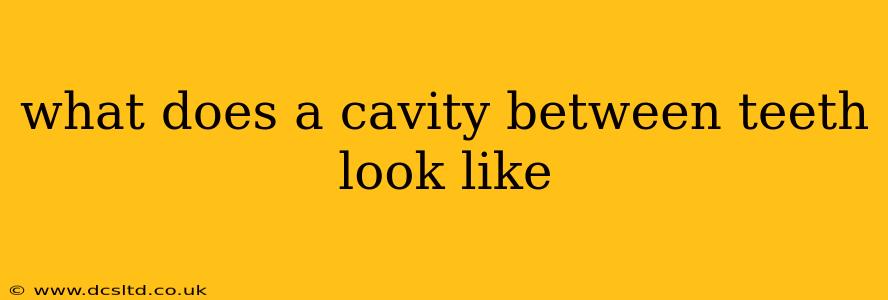A cavity between teeth, also known as an interproximal cavity, can be tricky to spot because it's hidden from plain view. Unlike cavities on the chewing surfaces, these often don't present with obvious holes or discoloration initially. This makes regular dental checkups crucial for early detection. So, what should you look for?
What are the early signs of a cavity between teeth?
Initially, you might not see anything at all. The decay starts between the teeth, often hidden beneath the gum line or in the grooves of the teeth. As it progresses, you might notice some subtle changes:
- Slight Discoloration: The area between your teeth might appear slightly darker than the surrounding enamel. This discoloration could be brown, black, or even yellowish. However, this is not always a clear indicator.
- Sensitivity to Sweets or Cold: This is a common early sign. If you experience sharp pain or sensitivity when consuming sweet or cold foods or drinks, especially in a specific area between your teeth, it warrants a dental check-up.
- Food Trapping: Do you find food consistently getting stuck between certain teeth, even after flossing? This could be a sign that the tooth structure is compromised and creating a space for food to lodge.
How does a cavity between teeth look as it progresses?
As the cavity worsens, it becomes more visible and noticeable. You might see:
- Visible Hole or Pit: A small hole or pit might become visible between your teeth. This signifies significant tooth decay.
- Larger Discoloration: The discoloration becomes more pronounced and extensive.
- Increased Sensitivity: The sensitivity to temperature changes and sweets will likely intensify.
- Bad Breath: Persistent bad breath that doesn't improve with brushing and flossing could be linked to decay.
- Pain: Severe toothache radiating from the affected area might occur, indicating advanced decay.
What should I do if I suspect a cavity between my teeth?
Don't delay! If you suspect a cavity between your teeth, even if you can't see anything, schedule an appointment with your dentist immediately. Early detection is key to preventing more extensive damage and the need for more complex and costly treatments.
How can I prevent cavities between my teeth?
Prevention is always better than cure. Here are some key strategies:
- Proper Brushing: Brush your teeth twice a day for at least two minutes each time, using fluoride toothpaste. Pay attention to the areas between your teeth, although a toothbrush can't effectively clean these areas entirely.
- Flossing Daily: Flossing removes food particles and plaque from between your teeth where your toothbrush can't reach. This is crucial in preventing cavities in these hidden areas.
- Regular Dental Checkups: Visit your dentist for regular checkups and professional cleanings. This allows for early detection and treatment of cavities before they become a significant problem.
- Healthy Diet: Limit sugary drinks and snacks. A diet rich in fruits and vegetables helps maintain overall oral health.
- Fluoride Treatments: Discuss fluoride treatments with your dentist. They can provide additional protection against tooth decay.
Can I see a cavity between my teeth with a mirror?
You might be able to see a significant cavity with a mirror, but it's difficult to detect smaller cavities in the early stages. The location between teeth makes it challenging to get a clear view. Therefore, relying solely on self-examination isn't reliable. Regular professional dental check-ups are essential for early cavity detection.
Are X-rays necessary to detect cavities between teeth?
Yes, X-rays (radiographs) are often essential for detecting cavities between teeth. X-rays can show cavities that are not visible to the naked eye, even with a mirror. Your dentist uses X-rays to assess the extent of decay and plan the appropriate treatment.
Remember, early detection and treatment are crucial for preserving your oral health. Don’t hesitate to schedule a dental appointment if you have any concerns.
